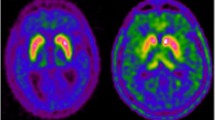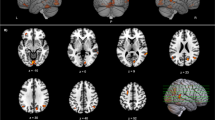Abstract
Parkinson’s disease (PD) patients show cognitive deficits that are relevant in terms of prognosis and quality of life. Degeneration of striatal dopaminergic afferents proceeds from dorsal/caudal to anterior/ventral and is discussed to account for some of these symptoms. Treatment with dopamine (DA) has differential effects on cognitive dysfunctions, improving some and worsening others. We hypothesized that cognitive performance during the dopaminergic OFF state correlates with DAT availability in the associative striatum. 16 PD patients underwent motor and cognitive examination ON and OFF DA. Global cognition was measured using the Montréal Cognitive Assessment (MoCA) test and executive functioning using a Stroop test. Nigrostriatal dopaminergic innervation was characterized with [123I]FP-CIT SPECT. A connectivity atlas of the striatum was used to assess DAT availability in functionally defined striatal subregions. Correlations between imaging data and behavioral data OFF medication were calculated. Correlations between DAT availability and MoCA performance in the dopaminergic OFF state was strongest in the associative part of the striatum (r = 0.674, p = 0.004). MoCA test performance did not differ between the ON and the OFF state. There was no correlation of DAT availability with Stroop performance in the OFF state but performance was significantly better during the ON state. Not only motor but also cognitive dysfunctions in PD are associated with striatal dopaminergic depletion. Cognitive decline in non-demented PD patients goes along with nigrostriatal degeneration, most pronounced in the associative subdivision of the striatum. In addition, the present findings suggest that executive dysfunctions are ameliorated by DA whereas global cognition is not improved by dopaminergic medication.


Similar content being viewed by others
References
Aarts E, Nusselein A, Smittenaar P, Helmich R, Bloem B, Cools R (2014) Greater striatal responses to medication in Parkinson’s disease are associated with better task-switching but worse reward performance. Neuropsychologia 62:390–397
Alexander GE, DeLong MR, Strick PL (1986) Parallel organization of functionally segregated circuits linking basal ganglia and cortex. Annu Rev Neurosci 9:357–381
Behrens TEJ, Johansen-Berg H, Woolrich MW, Smith SM, Wheeler-Kingshott CAM, Boulby PA, Barker GJ, Sillery EL, Sheehan K, Ciccarelli O, Thompson AJ, Brady JM, Matthews PM (2003) Non-invasive mapping of connections between human thalamus and cortex using diffusion imaging. Nat Neurosci 6:750–757
Booij J, Kemp P (2007) Dopamine transporter imaging with [(123)I]FP-CIT SPECT: potential effects of drugs. Eur J Nucl Med Mol I 35:424–438
Brück Portin, Lindell Laihinen, Bergman Haaparanta, Solin Rinne (2001) Positron emission tomography shows that impaired frontal lobe functioning in Parkinson’s disease is related to dopaminergic hypofunction in the caudate nucleus. Neurosci Lett 311:81–84
Brück A, Aalto S, Nurmi E, Vahlberg T, Bergman J, Rinne J (2006) Striatal subregional 6-[18F]fluoro-l-dopa uptake in early Parkinson’s disease: a two-year follow-up study. Mov Disord Off J Mov Disord Soc 21:958–963
Buchert R, Kluge A, Tossici-Bolt L, Dickson J, Bronzel M, Lange C, Asenbaum S, Booij J, Kapucu Ö, Svarer C, Koulibaly P-M, Nobili F, Pagani M, Sabri O, Sera T, Tatsch K, Borght T, Laere K, Varrone A, Iida H (2016) Reduction in camera-specific variability in [123I]FP-CIT SPECT outcome measures by image reconstruction optimized for multisite settings: impact on age-dependence of the specific binding ratio in the ENC-DAT database of healthy controls. Eur J Nucl Med Mol I 43:1323–1336
Bullinger M (1995) German translation and psychometric testing of the SF-36 Health Survey: preliminary results from the IQOLA Project. Int Qual Life Assess Soc Sci Med 41:1359–1366
Chou K, Lenhart A, Koeppe R, Bohnen N (2014) Abnormal MoCA and normal range MMSE scores in Parkinson disease without dementia: cognitive and neurochemical correlates. Parkinsonism Relat Disord 20:1076–1080
Christopher L, Marras C, Duff-Canning S, Koshimori Y, Chen R, Boileau I, Segura B, Monchi O, Lang A, Rusjan P, Houle S, Strafella A (2014) Combined insular and striatal dopamine dysfunction are associated with executive deficits in Parkinson’s disease with mild cognitive impairment. Brain 137:565–575
Cools R, Barker R, Sahakian B, Robbins T (2003) l-Dopa medication remediates cognitive inflexibility, but increases impulsivity in patients with Parkinson’s disease. Neuropsychologia 41:1431–1441
Cools R, Altamirano L, D’Esposito M (2006) Reversal learning in Parkinson’s disease depends on medication status and outcome valence. Neuropsychologia 44:1663–1673
Costa A, la Fougère C, Pogarell O, Möller H-J, Riedel M, Ettinger U (2013) Impulsivity is related to striatal dopamine transporter availability in healthy males. Psychiatry Res Neuroimaging 211:251–256
Costa A, Peppe A, Mazzù I, Longarzo M, Caltagirone C, Carlesimo G (2014) Dopamine treatment and cognitive functioning in individuals with Parkinson’s disease: the “cognitive flexibility”. Hypothesis seems to work. Behav Neurol 2014:260896
Dalrymple-Alford JC, MacAskill MR, Nakas CT, Livingston L, Graham C, Crucian GP, Melzer TR, Kirwan J, Keenan R, Wells S, Porter RJ, Watts R, Anderson TJ (2010) The MoCA: well-suited screen for cognitive impairment in Parkinson disease. Neurology 75:1717–1725
Darcourt J, Booij J, Tatsch K, Varrone A, Borght T, Kapucu Ö, Någren K, Nobili F, Walker Z, Laere K (2010) EANM procedure guidelines for brain neurotransmission SPECT using 123I-labelled dopamine transporter ligands, version 2. Eur J Nucl Med Mol I 37:443–450
Fera F, Nicoletti G, Cerasa A, Romeo N, Gallo O, Gioia M, Arabia G, Pugliese P, Zappia M, Quattrone A (2007) Dopaminergic modulation of cognitive interference after pharmacological washout in Parkinson’s disease. Brain Res Bull 74:75–83
Halliday G, Leverenz J, Schneider J, Adler C (2014) The neurobiological basis of cognitive impairment in Parkinson’s disease. Mov Disord 29:634–650
Hartmann A, Rief W, Hilbert A (2011) Psychometric properties of the German version of the Barratt Impulsiveness Scale, Version 11 (BIS-11) for adolescents. Percept Motor Skill 112:353–368
Hautzinger M (1991) The Beck Depression Inventory in clinical practice. Nervenarzt 62:689–696
Hughes AJ, Daniel SE, Kilford L, Lees AJ (1992) Accuracy of clinical diagnosis of idiopathic Parkinson’s disease: a clinico-pathological study of 100 cases. J Neurol Neurosurg Psychiatry 55:181–184
Kaasinen V, Rinne J (2002) Functional imaging studies of dopamine system and cognition in normal aging and Parkinson’s disease. Neurosci Biobehav Rev 26:785–793
Kish SJ, Shannak K, Hornykiewicz O (1988) Uneven pattern of dopamine loss in the striatum of patients with idiopathic Parkinson’s disease. Pathophysiologic and clinical implications. N Engl J Med 318:876–880
Kupitz D, Apostolova I, Lange C, Ulrich G, Amthauer H, Brenner W, Buchert R (2014) Global scaling for semi-quantitative analysis in FP-CIT SPECT. Nuklearmedizin Nucl Med 53:234–241
Lange C, Seese A, Schwarzenböck S, Steinhoff K, Umland-Seidler B, Krause B, Brenner W, Sabri O, Kurth J, Hesse S, Buchert R (2014) CT-based attenuation correction in I-123-ioflupane SPECT. PLoS One 9:e108328
MacDonald A, Monchi O, Seergobin K, Ganjavi H, Tamjeedi R, MacDonald P (2013) Parkinson’s disease duration determines effect of dopaminergic therapy on ventral striatum function. Mov Disord 28:153–160
Pellecchia Picillo, Santangelo Longo, Moccia Erro, Amboni Vitale, Vicidomini Salvatore, Barone Pappatà (2015) Cognitive performances and DAT imaging in early Parkinson’s disease with mild cognitive impairment: a preliminary study. Acta Neurol Scand 131:275–281
Polito C, Berti V, Ramat S, Vanzi E, Cristofaro M, Pellicanò G, Mungai F, Marini P, Formiconi A, Sorbi S, Pupi A (2012) Interaction of caudate dopamine depletion and brain metabolic changes with cognitive dysfunction in early Parkinson’s disease. Neurobiol Aging 33:206.e29–206.e39
Ramani L, Malek N, Patterson J, Nissen T, Newman EJ (2016) Relationship between [123I]-FP-CIT SPECT and clinical progression in Parkinson’s disease. Acta Neurol Scand 134:378–381
Rektorova I, Srovnalova H, Kubikova R, Prasek J (2008) Striatal dopamine transporter imaging correlates with depressive symptoms and tower of London task performance in Parkinson’s disease. Mov Disord 23:1580–1587
Rinne J, Portin R, Ruottinen H, Nurmi E, Bergman J, Haaparanta M, Solin O (2000) Cognitive impairment and the brain dopaminergic system in Parkinson disease: [18F]fluorodopa positron emission tomographic study. Arch Neurol Chicago 57:470–475
Robbins T, Cools R (2014) Cognitive deficits in Parkinson’s disease: a cognitive neuroscience perspective. Mov Disord 29:597–607
Siepel F, Brønnick K, Booij J, Ravina B, Lebedev A, Pereira J, Grüner R, Aarsland D (2014) Cognitive executive impairment and dopaminergic deficits in de novo Parkinson’s disease. Mov Disord 29:1802–1808
Stroop JR (1935) Studies of interference in serial verbal reactions. J Exp Psychol 18(6):643–662. doi:10.1037/h0054651
Turkheimer FE, Smith CB, Schmidt K (2001) Estimation of the number of “true” null hypotheses in multivariate analysis of neuroimaging data. Neuroimage 13:920–930
Tziortzi A, Haber S, Searle G, Tsoumpas C, Long C, Shotbolt P, Douaud G, Jbabdi S, Behrens T, Rabiner E, Jenkinson M, Gunn R (2014) Connectivity-based functional analysis of dopamine release in the striatum using diffusion-weighted MRI and positron emission tomography. Cereb Cortex 24:1165–1177
Vaillancourt D, Schonfeld D, Kwak Y, Bohnen N, Seidler R (2013) Dopamine overdose hypothesis: evidence and clinical implications. Mov Disord 28:1920–1929
Author information
Authors and Affiliations
Corresponding author
Ethics declarations
Funding
The project was funded by the DFG (German research Council, grant KU2261/6-1) to AAK. Dorothee Kübler is a participant in the BIH-Charité Clinician Scientist Program funded by the Charité-Universitätsmedizin Berlin and the Berlin Institute of Health.
Conflict of interest
The authors declare that they have no conflict of interest.
Rights and permissions
About this article
Cite this article
Kübler, D., Schroll, H., Buchert, R. et al. Cognitive performance correlates with the degree of dopaminergic degeneration in the associative part of the striatum in non-demented Parkinson’s patients. J Neural Transm 124, 1073–1081 (2017). https://doi.org/10.1007/s00702-017-1747-2
Received:
Accepted:
Published:
Issue Date:
DOI: https://doi.org/10.1007/s00702-017-1747-2




